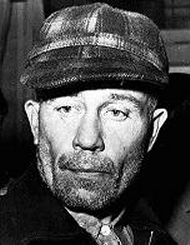Ed Gein
Ed Gein was a middle-of-the-road American virtually indistinct from any other. That is, until Green Lake County sheriffs laid eyes on the grisly trophies and skinned body of Gein’s latest victim. Operating off a tip, law enforcement in 1957 was stunned at the horror of tearing the veil off Gein’s hidden horror funhouse. A human body hung as if skinned, a human head waiting in a kitchen saucepan, and authentic (and recent) skeletons making up the décor were only some of the horrific scenes awaiting them.

Gein had a horror show waiting for any intruder, which he had taken pains to prevent. But the unmitigated contempt for human life Gein showed demonstrated to law enforcement that his victims were merely part of an elaborate scheme. While some serial killers concentrate on their thrill in the moment, Ed Gein was titled the Butcher of Plainfield for the gruesome catalog of body parts and startling inventory of bizarre trophy after effects of the victims’ remains.
Ed Gein was the model for Norman Bates in “Psycho”, and other cinematic horror figures; this rural Wisconsin farmer practiced deviant and depraved acts on both corpses and living victims. Gein doesn’t exactly fit the description of a serial killer, though like many serial killers, Ed Gein benefited from a complacent American small town lifestyle and a police force without advanced modern forensic techniques. Gein’s bachelor existence, rural lifestyle, and stern upbringing made for a snapshot of his personality as a curiosity.
Ed dressed his “meats” efficiently, like any son of the Wisconsin hunting fields. But decapitated corpses and bodies skinned for product yield was a stark shock for lawmen. The Ed Gein house was a trash filled chaotic jumble of dirty possessions and corpse pieces, collected pieces of the human body and actual knickknacks Ed Gein had made. A belt made of women’s nipples, a window shade pull made out of carved human lips, an upholstery of skin, fashioned real-skin face masks and other paraphernalia were found within the home.
Unearthed in a paper bag was a familiar face, decapitated. The missing Mary Hogan had been found. The search of Ed Gein’s house that had been initiated for a missing hardware store owner where Gein had been shopping the day before her absence was noticed led to other discoveries. Ed Gein also had been involved with experiments and “crafts” on dead bodies Ed Gein had sourced from local cemeteries. The Gein rationale and the underlying reasons for his killings were as macabre.
A flabbergasted Plainfield watched the news, astounded at the disturbed murdering man from within their midst. The sights inside the Ed Gein house traumatized police officers, but creepier than anything else was the preserved room shrine where Ed Gein observed respect for his mother. Community folk who knew Ed as the town babysitter or handyman gulped anew.
The pathology of Ed Gein’s mental health and the imprint of a religious mother became clear over time. The personality boundaries between Augusta Gein and her husband and sons were almost indistinct. Life on the family farm threw Henry and Ed under the sway of the mother alone after their father’s death.
Ed Gein’s life narrowed after a withdrawal from school. Sane behavior, meaningful social interchange with other people, and peer reinforcement were almost totally absent from the Ed Gein history. Augusta Gein had suffered strokes and the psychological dependence Ed Gein had on her for his every life and breath was in turn fostered by an unusual closeness of a nurse or body servant.
Ed Gein became the family handyman familiar to the Plainfield households, which caused a serious reaction when the murders were discovered. Yet in the aftermath of the depravity discoveries, women in Plainfield expressed instincts of fear, wariness and aversion to the Ed Gein social experience. Ed Gein lived without indoor plumbing, electricity, clubs or involvements, or human companionship. But in his mind, the continuing thread of the Augusta Gein and her mores dominated his life.
Gein started to evolve as a social being by replacing the vacuum of his mother in the house with the imagined “people” of the corpses. Primarily Ed Gein created mirror images of his mother, sometimes personifying her by wearing the “garments” he had created out of the deceased corpse materials. When Gein moved onto the human victims, his career was short. A tough talking tavern owner and a mature hardware store owner, both women of a certain age or older, were the known extent of his murders.
But the extent of the collection of body parts and corpse items in the Gein house made some suspect that Bernice Warden of Warden’s hardware, and the coarse, foulmouthed Mary Hogan of Hogan’s tavern may not have been the only women he killed. It seems that Augusta Gein’s programming against women as the root of all evil made her his only female personality of importance for his entire lifetime. As the Mad Butcher of Plainfield aged in a mental institution, the crimes faded from notoriety.
The auction of the Gein house and possessions was overshadowed by a mysterious fire, which leveled the spooky farmhouse that shocked visiting police all those years ago. Ed Gein proved to be the inspiration for the Alfred Hitchcock movie “Psycho”, the Johnathan Demme film “Silence of the Lambs”, and Tobe Hooper horror hit “The Texas Chainsaw Massacre”. The cultural fascination with one of the most extreme of all insane killers ever, may never fade.
Article by Roy Whyte . Visit his Google+ page for more.



